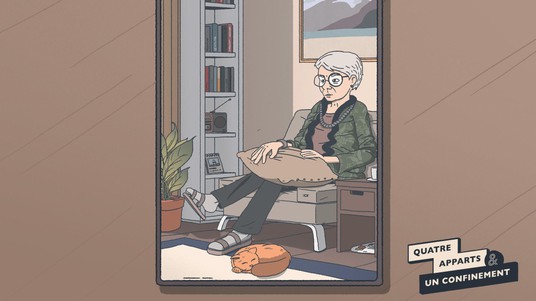Researchers launch video game exploring the effects of confinement

Scenes from "Quatre apparts et un confinement" © Mathias Hängärtner
An interactive video game created by researchers and students in the College of Humanities (CDH) and UNIL Gamelab, in collaboration with the Initiative for Media Innovation (IMI) and Le Temps, allows users to explore a series of digital narratives that bear witness to the period of pandemic-induced isolation.
Would you let your children play in the park? How can you stay focused during your distance-learning course? Who are you going to call to pass the time while semi-confined? People across the world are dealing with these questions, and many more, as social distancing and confinement have become key strategies for fighting the coronavirus pandemic.
For CDH scientist and UNIL Gamelab researcher Yannick Rochat, an expert in game studies and digital humanities, a narrative video game seemed like a natural medium for exploring these questions, and how different people struggle to respond to them in different ways.
“Video games can convey information as well as emotions. The idea behind this game is to have a testimony to this period in history that has impacted us all. For a newspaper like Le Temps and for a researcher like myself, it is important to document and keep an account of these experiences,” he says.
On August 20th, Rochat and a team of collaborators from the worlds of gaming, programming, and graphic design released “Quatre apparts et un confinement” (Four Condos and a Containment): a series of interactive, choose-your-own-adventure stories that dramatize the lives of four fictitious neighbors in the same building.
Confinement through the eyes of others
The francophone game was developed in June and July, 2020, thanks to the (socially distanced) collaboration of IMI Director Mounir Krichane, Le Temps journalist Paul Ronga, graphic designer Mathias Hängärtner, EPFL student Andrew Dobis, and UNIL student Saara Jones. It is hosted on Le Temps’ website and mobile app.
Users can click through the digital apartments, visiting each character and participating briefly in their lives: their decisions, their worries, their desires, or their frustrations. Some experiences may seem familiar to users, while some present a window into what others may be feeling during confinement.
“This video game allows us to tell the story of confinement from different angles, while allowing the player to participate. This represents an important opportunity to relive confinement, but from the perspective of another person – for example, a single mother, an elderly woman, or a student,” Rochat explains. He adds that the mobile-friendly, point-and-click format was inspired in part by narrative video games like Florence, but with the added complexity of text and dialogue.
IMI Director Mounir Krichane also explains that beyond the game’s instructive aspect, which reflects educational offerings at EPFL and at UNIL on video games, “Quatre apparts” is also a way for IMI and its partners to explore new modes of storytelling, including interactive formats.
“With most media organizations now facing the question of audience renewal, interactive formats are a way to remain relevant to changing audiences while also attracting new ones, especially among younger generations,” he says.
Thanks to its open-source code, the creators also emphasize that other media and institutions are invited to publish or adapt the unique gaming experience, for example into other languages.



